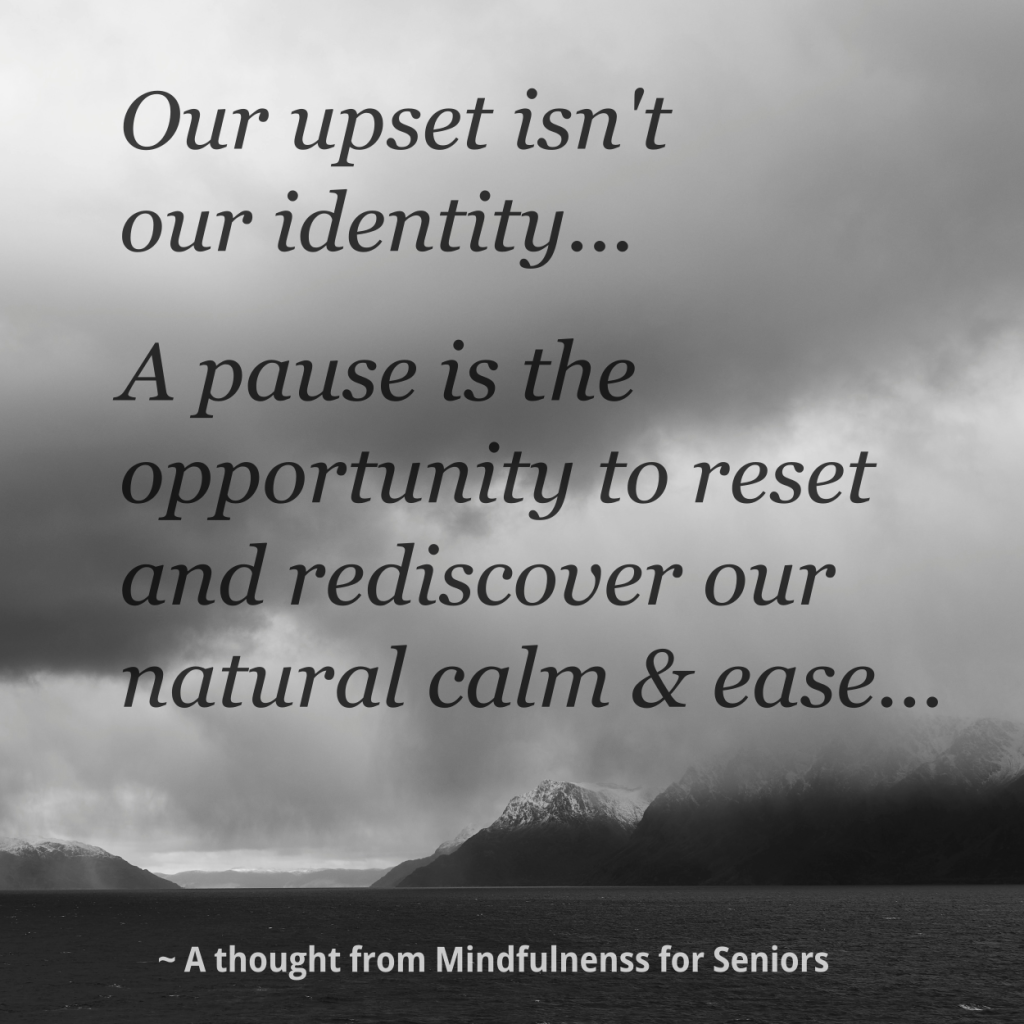Tips for Seniors: Navigating Emotional Storms With Mindfulness
Why Your Mindfulness Toolkit Matters Most When Things Get Rough
I recently had a moment where I felt completely derailed by an unexpected emotional storm. It was a perfect storm of intrusion, frustration, and an emotional habit that I thought I had left behind. For about 24 hours, it felt like a heavy cloud had moved in, and I had to use every tool in my kit to find my way back to mental calm and emotional balance. That experience reminded me that mindfulness isn’t about avoiding the storms of life; it’s about having a proven toolkit for when they inevitably hit.
It’s important to understand that mindfulness is not a shield that prevents bad feelings or a panacea that fixes or removes all of our problems. In the case of severe emotional upset, a great way to think of mindfulness is as a fire extinguisher for your emotional flames. It’s having a set of simple, ready-to-use strategies and tools to help you calm the heat of upset when things get overwhelming or feel out of control. This approach acts as a life preserver, allowing you to protect yourself and, just as importantly, insulate others from the ripple effects of your upset. By creating that crucial pause, mindfulness empowers you to respond thoughtfully, helping you embody the highest version of yourself.

When an Emotional Storm Hits: Your Immediate Reset Buttons
Sometimes, emotions feel too intense—like a storm or tornado—for the gentle observation that traditional mindfulness is often associated with. During these experiences, we need powerful tools that can immediately help cool the flames. To my thinking, these techniques are absolutely a part of mindfulness. Why? Because you’ve deployed the awareness that gives you options and the self-knowledge to know when a simple “allowing” or calm observation won’t work for you. That is a core part of mindfulness. These “extra tools” are a simple, yet effective way to interrupt the overwhelming momentum of upset, protect your mental and emotional well-being, and respect those around you through self-management.
Here are some effective “Upset Interrupt” strategies that can be used singly or as many as you feel the need to incorporate (During my recent upset, I had to use all of these strategies!):
- Do No Harm: This is crucial. Avoid saying or doing anything you might later regret, to yourself or to others, like yelling, sending a rash email, or getting behind the wheel of a car when you are upset.
- Remove Yourself: Physically step away from the person, place, or situation causing the upset. Go to another room or step outside for a few minutes.
- Just Notice 10 Things: This simple tool works by giving your overwhelmed mind a new, easy job to do. Instead of trying to “fix” the difficult feeling, you simply look for and count ten simple things around you, like books on a shelf or flowers in a vase. The act of looking and counting helps your brain calm down and signals your nervous system to stand down from high alert. (If ten things is not enough, go with ten more, or even 100. Use this “active noticing” as an adaptable tool to suit the level of upset).
- Engage Your Breath: Take a few simple, conscious deep breaths to help dissipate intense emotional energy. This isn’t about perfect technique, just about taking intentional breaths. (If a few breaths are not enough, try combining this with gentle physical movement to soothe the upset).
- Move Your Body: Engage in simple physical movement to release pent-up energy, always within your ability. This could be pacing, gentle stretching, or even just getting up and sitting down in a chair repeatedly. Squeezing and releasing a pillow is also a great option.
Your Toolkit for After the Flames of Upset Have Passed: Building Resilience
Once the immediate emotional storm has passed and the heat of upset has cooled, and you’ve regained some degree of mental and emotional calm, the more well-known and gentle tools of mindfulness are there to help you process what happened and build your resilience for next time.
- Recognize and Accept the Emotion(s): Just notice what you felt and what you’re still feeling. It’s okay to feel upset, hurt, or angry. Emotions are a natural part of being human. With the major upset past, you’re now able to move to observation of those feelings rather than being carried away by them.
- Observe the Sensations: Where did you feel this emotion in your body? A tightness in your chest? A knot in your stomach? A tense jaw or clenched fists? Gently notice these physical sensations with an open, non-biased awareness. If the sensations are still present, you can continue this observation and also work with the sensations through relaxation or visualization techniques.
- Work with the Thoughts: Our minds love to chatter! Notice the thoughts that came with the emotions. Do they seem familiar? Are they a mental pattern or thinking habit you recognize? Once the big upset has passed, it’s much easier to remind yourself they are just thoughts, not necessarily facts. With some of your newly returned calm, it’s much easier to gently guide your attention away from unhelpful patterns or intentionally question the thinking habits that you feel no longer serve you.
Want to learn more? Sign up for our free inspirational bi-weekly newsletter or download our 100% free “A Taste of Mindfulness for Seniors” PDF (no email required).
Embrace Your Journey with Kindness
Remember, your mindfulness journey is yours alone to shape. It’s a path of gentleness, curiosity, and self-compassion. Even a single mindful breath can be enough to transform your perception and open you to a calmer, more joyful way of experiencing life. So, take a breath, be kind to yourself, and enjoy the ride!
Disclaimer: The information provided in this article is for educational purposes only and is not intended as a substitute for professional medical or mental health advice, diagnosis, or treatment. The author is not a licensed medical or mental health professional. Please consult with your physician or a qualified healthcare provider with any questions you may have regarding a medical condition.


Comments
One response to “Navigating Emotional Storms With Mindfulness”
[…] we talked about a toolkit for emotional storms. We discussed why mindfulness isn’t a shield against big upsets or extreme feelings, but a […]